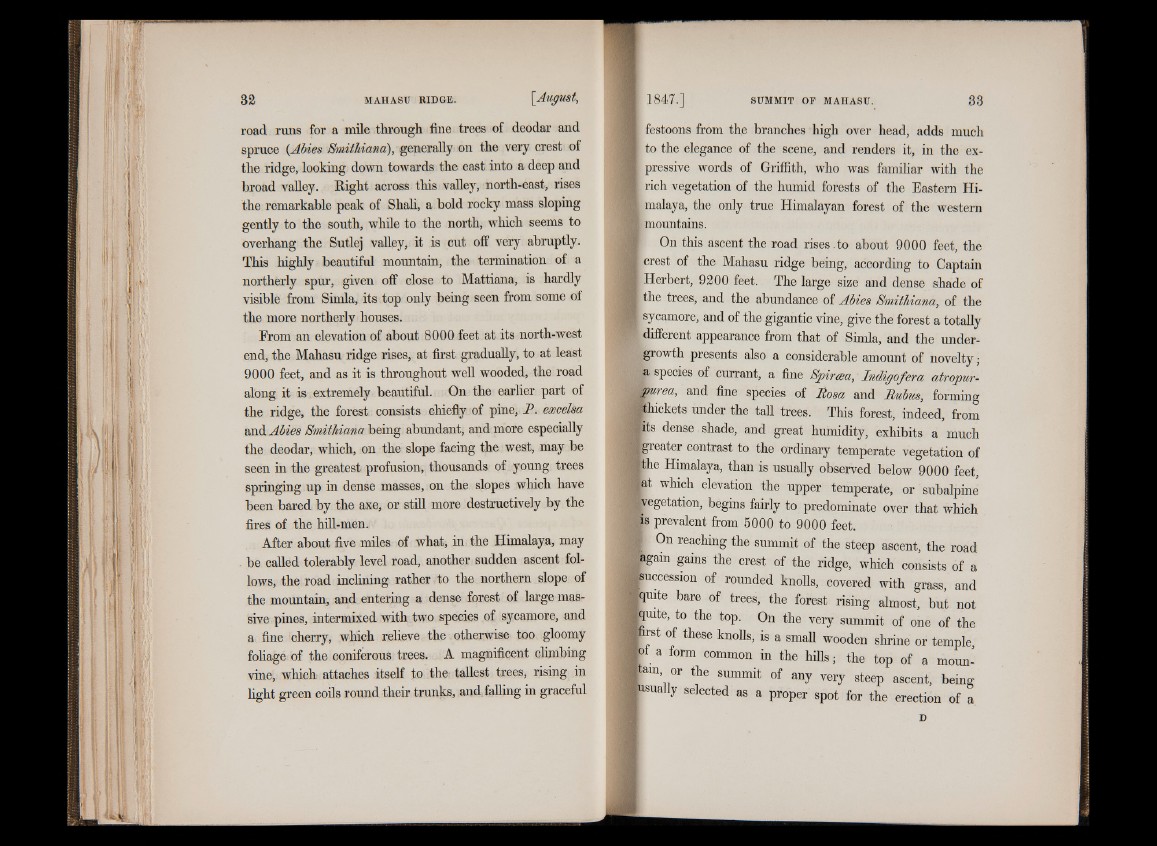
road runs for a mile through fine trees of deodar and
spruce (Abies Smithiana), generally on the very crest of
the ridge, looking down towards the east into a deep and
broad valley. Right across this valley, north-east, rises
the remarkable peak of Shali, a bold rocky mass sloping
gently to the south, while to the north, which seems to
overhang the Sutlej valley, it is cut off very abruptly.
This highly beautiful mountain, the termination of a
northerly spur, given off close to Mattiana, is hardly
visible from Simla, its top only being seen from some of
the more northerly houses.
From an elevation of about 8000 feet at its north-west
end, the Mahasu ridge rises, at first gradually, to at least
9000 feet, and as it is throughout well wooded, the road
along it is extremely beautiful. On the earlier part of
the ridge, the forest consists chiefly of pine, P. excelsa
and Abies Smithiana being abundant, and more especially
the deodar, which, on the slope facing the west, may be
seen in the greatest profusion, thousands of young trees
springing up in dense masses, on the slopes which have
been bared by the axe, or still more destructively by the
fires of the hill-men.
After about five miles of what, in the Himalaya, may
. be called tolerably level road, another sudden ascent follows,
the road inclining rather to the northern slope of
the mountain, and entering a dense forest of large massive
pines, intermixed with two species of sycamore, and
a fine cherry, which relieve the otherwise too gloomy
foliage of the coniferous trees. A magnificent climbing
vine, which attaches itself to the tallest trees, rising in
light green coils round their trunks, and, falling in graceful
I festoons from the branches high over head, adds much
I to the elegance of the scene, and renders it, in the ex-
I pressive words of Griffith, who was familiar with the
I rich vegetation of the humid forests of the Eastern Hi-
I malaya, the only true Himalayan forest of the western
1 mountains.
On this ascent the road rises.to about 9000 feet, the
■ crest of the Mahasu ridge being, according to Captain
I Herbert, 9200 feet. The large size and dense shade of
■the trees, and the abundance of Abies Smithiana, of the
■sycamore, and of the gigantic vine, give the forest a totally
^different appearance from that of Simla, and the undergrowth
presents also a considerable amount of novelty■
a species of currant, a fine Spircea, Indigofera atrojpur-
jjjkmrea, and fine species of Sosa and JRubus, forming
Buckets under the tall trees. This forest, indeed, from
Jits dense shade, and great humidity, exhibits a much
■greater contrast to the ordinary temperate vegetation of
She Himalaya, than is usually observed below 9000 feet,
Jat which elevation the upper temperate, or subalpine
■vegetation, begins fairly to predominate over that which
is prevalent from 5000 to 9000 feet.
On reaching the summit of the steep ascent, the road
fg ain gains the crest of the ridge, which consists of a
¡succession of rounded knolls, covered with grass, and
■quite bare of trees, the forest rising almost, but not
Imte, to the top. On the very summit of one of the
jfrst of these knolls, is a small wooden shrine or temple,
lot a form common in the hills; the top of a moun-
|am, or the summit of any very steep ascent, being
psually selected as a proper spot for the erection of a